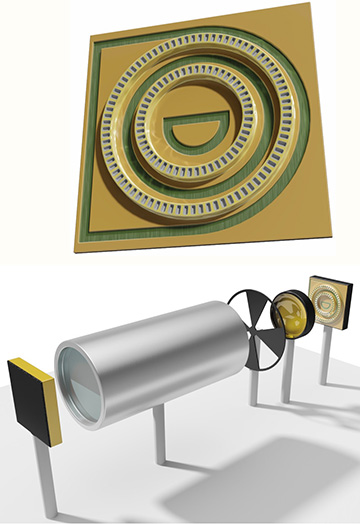
In the TU Wien design, quantum cascade heterostructures are arrayed within concentric ring-shaped waveguides (top; diameter of outer ring is 400 microns), and can act as both sources and detectors of light on the same chip. In the specific setup tested by the lab (bottom), one of the ring structures (on the right), acting in QCL mode, sends its light through a chamber containing the gas to be analyzed. The beam is reflected by a mirror (on the left) and sent back through the chamber, to be picked up by the other ring structure, acting in detector mode. [Image: TU Wien]
Quantum cascade lasers (QCL) excel as mid-infrared light sources, a characteristic that has made them a linchpin in many environmental and industrial gas-sensing applications. But though QCLs themselves can be quite small, actually setting up a sensor system requires other elements beyond the laser, which can make it tough to design compact devices ready for field use.
A team of scientists from the Vienna University of Technology (TU Wien), Austria, now offers a concept that the group believes could make designing handheld QCL-based sensors a lot easier. The key: a clever scheme that combines the laser and the detector on a single chip less than half a millimeter across (ACS Photon., doi: 10.1021/acsphotonics.6b00603).
Using bifunctional QCLs
The mid-infrared operating zone of QCLs puts them squarely in the “molecular fingerprint” spectral region for use in sensing a wide variety of organic and inorganic molecules (see “Air-quality monitoring in the mid-infrared,” OPN, November 2015). A typical QCL-based sensor would consist of the laser source, a cell or chamber in which the light would interact with the gas to be analyzed, and a separate detector, to read which wavelengths have been absorbed by the gas—spectral data that can then be used to infer the molecular composition. And there’s the rub: the need for these separate components beyond the laser itself tends to increase the size and complexity of detectors, making it harder to design field-ready units.
One possible way around this is to use the QCL both as the light source and the detector. It’s been known for more than a decade that the heterostructures used to build QCLs can also operate in detector mode. Only in the past few years, however, have truly bifunctional quantum cascade heterostructures emerged that allow both emission and absorption at the same wavelengths, and thus have the potential to do double duty in a compact sensor setup.
A ring laser/detector combo
To get to such a compact setup, the TU Wien team, led by Gottfried Strasser and Bernhard Lendl, used molecular-beam epitaxy to monolithically grow InGaAs/As quantum cascade heterostructures on a tiny InP chip. The heterostructures were arrayed in distributed-feedback (DFB) gratings within two concentric circlular waveguides, with respective diameters of 400 and 330 microns.
The circular setup is thus that of a ring laser, taking advantage of whispering-gallery modes for amplification. The DFB structure, meanwhile, acts both to tailor the heterostructure’s single-mode emission (when the structure is acting as a light source) and to serve as a coupling element when the heterostructure is absorbing light (that is, when it’s acting as a detector).
In the lab’s sensor scheme, the chip sits at one end of the cell containing the gas to be analyzed, with a mirror fixed at the other end. A laser emission from one of the rings is directed through the cell, hits the mirror and passes back through the cell—where the other quantum cascade ring, operating in detector mode, absorbs the light and sends the spectral data to the researcher for analysis. The two rings then instantly swap roles for the next measurement: the detecting ring becomes the emitter and the emitting ring switches into detector mode.
Possibilities in remote sensing
In addition to integrating source and detector on the same chip, the researchers note, the setup also effectively doubles the interaction length of the laser light through the cell—thereby potentially increasing the device’s sensitivity. The team tested out the setup with a combination of isobutane and isobutene gas, and was able to clearly distinguish the spectral signatures of each, and to reach a limit of detection below 400 parts per million for isobutane in particular.
Team leader Gottfried Strasser believes that the concept could allow “for the production of extremely compact sensors, and conceivably, even an entire array—a cluster of microsensors—housed on a single chip and able to operate on several different wavelengths simultaneously.” The compact sensor concept, the researchers believe, could find use in handheld, on-site detection tools for in a variety of settings, including environmental monitoring and medicine.
